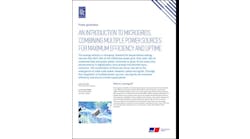Credit: Pacific Northwest National Laboratory
Udi Merhav, of EnergyOrbit, explains the new world of demand-side management, where utilities earn a rate of return on ‘degeneration.’
As more and more renewable generation sources come online and energy programs like demand response proliferate in the US and abroad, a decades-long struggle is nearing a critical tipping point.
Utilities, once threatened by the new sources and systems created as a result of renewables have undergone a gradual movement towards realigning their internal programs and incentive structures to increase efficiency, reduce cost, and cut emissions.
While it seems obvious today why energy efficiency, demand response, and renewable energy programs should be seamlessly integrated, these programs grew up under disparate circumstances in the utility environment, and it is only in the past few years that the landscape has become increasingly ripe for their integration and greater adoption. Once stacked against the adoption of EE, DR, and renewables, utilities have heard and responded to what many predicted as their death knell and have emerged with realigned incentives for a better environment, a more nimble business strategy and a new focus—the consumer.
The prevailing mindset of the utilities until the 90s was to sell as much electricity as possible. This meant building as many power plants and generating as much electricity as possible to support an “always-on” philosophy. Unfortunately, that attitude came at the cost of many negative externalities – namely environmental and end-consumer costs.
Ironically, energy efficiency first emerged as a mechanism not for reducing utilities’ energy footprint, but as a way to offsetting the risk to utilities of “ratepayers” likelihood of defaulting on monthly energy payments. Third parties and other stakeholders began to finance these efficiency programs first for low-income ratepayers, and slowly these programs began to grow. But, utilities still didn’t have a real incentive to do energy efficiency.
Renewables, like energy efficiency started in the 1970’s about the time of the gas shortages. Demand Response started to take off in the 1990’s as a fix for generation and power shortages, whether real or contrived in the west during the Enron era. As it became harder for power plants and transmission lines to be sited, environmental concerns and “not in my neighborhood” concerns led to the take off of both DR and renewables.
The advent of deregulation was really an inflection point in the industry. Utilities began to decouple their revenue from electricity sales and that was the point at which energy efficiency really took off and demand response moved in. Utilities began to ask: do we have enough power at any given time? If utilities didn’t have the money to build another power plant, demand response was used as a supplement.
Moving towards a brave new utility
Today, the “new utility” is one that is decoupled, makes a rate of return on generation, but also on degeneration. Although the ROI on degeneration isn’t as high, it helps and is a starting point. And, while there is a lot of discussion around the “new utility,” nothing in the utility industry will happen overnight. Eventually the new model will takeover and the ROI for generation will be something like 1x, demand response and energy efficiency will be 2x the ROI and renewables will be 3x the return. We are not there yet.
In contrast to what has been a siloed approach to energy efficiency, demand response and renewables, progressive utilities are now moving towards a more holistic approach.
The promise of an integrated demand side management program gives the utilities a place to start. Companies like EnerNOC, which started in DR and went into EE, and Opower, which started in EE and is integrating DR, are both beginning to successfully unite energy efficiency with demand response and see a longer vision of these two programs synchronized.
Having customer information to appropriately engage is key to offering the right programs to the right residents, while a real time view of the customer’s energy history allows utilities to provide tailored programs and the ability to create a more integrated environment for the customers that want to participate in energy efficiency, demand response, and distributed generation or renewables.
The realization is that you’ve got customers that are proactively green, dubbed “prosumers” and those that are uninterested. Each type of customer will either opt into or out of these programs. An integrated solution helps lower utilities’ marketing costs to effectively target solutions to those already intent on energy conservation and clean energy.
The opportunity to create economic value from the grid is being heavily reexamined. States like Colorado, California, Hawaii, Massachusetts, and New York are retooling existing regulatory framework for delivering electricity and introducing legislation that further incentivizes energy efficiency, demand response and renewables.
The next generation of utility business models are considering performance-based ratemaking, which aims to create new revenue streams from demand side technologies like distributed solar and energy efficiency.
Colorado recently introduced Bill 1250, which “prioritizes developing a performance-based regulatory system that will drive innovation and promote economic development in a variety of technologies.” And New York’s Reforming The Energy Vision (REV) Initiative affords the utility a new role to manage the distributed resource platform. These legislative shifts will challenge business-as-usual and spur the next wave of clean energy innovation.
Udi Merhav is CEO & founder of EnergyOrbit







